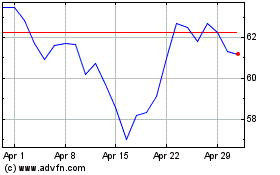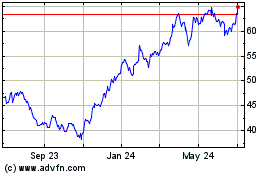WASHINGTON—Lawmakers are looking to extract more than a billion
dollars a year in fresh funds from banks in the U.S.
The proposal, already approved by the Senate, would cut the
annual dividend payments banks receive for holding shares in the
Federal Reserve System and use the savings for highway
construction.
The payments under that obscure, century-old program totaled
$1.69 billion last year, including roughly $310 million for Bank of
America Corp. and $250 million for Citigroup Inc., according to the
Fed and a Wall Street Journal analysis of regulatory filings.
The proposal surfaced this past summer in a highway-funding bill
backed by Senate Majority Leader Mitch McConnell (R., Ky.) and was
passed by the Senate in July. House GOP leaders haven't moved on
the Senate bill and haven't taken a position on the bank-payments
issue. Some Democrats in the House, however, have said they would
support it. The House is expected to decide its approach on the
highway bill before month's end.
The collapse of talks to produce an ambitious business-tax
overhaul to pay for highway programs means the House is under some
pressure to take up the Senate-passed bill, which includes the bank
provision.
Representatives of Citigroup, Bank of America and other lenders
have descended on Capitol Hill in protest. They warn that cutting
the dividends could prompt smaller banks to flee the Federal
Reserve System in search of other regulators and said it is unfair
to put the burden of unrelated highway spending on their
operations.
It doesn't make sense, said Rusty Cloutier, president of
MidSouth Bancorp Inc. of Lafayette, La., who figures the dividend
cut would shave one or two cents a share off his bank's annual
earnings. "Am I going to get free toll passes or something?" he
said.
Bank of America and Citigroup declined to comment.
Lawmakers are looking at the Fed program to pay for roads in
part because they have been unwilling to raise the gasoline tax, a
primary source of cash for highways that Congress hasn't increased
since 1993.
The bank-dividend policy dates to 1913, when Congress created
the Federal Reserve System. To win support, lawmakers divided Fed
control between a board based in Washington, D.C., and 12 regional
Fed banks. Funding those banks with taxpayer dollars was unpopular,
so lawmakers asked private banks to become "members" of the Fed and
buy stock in the regional Fed banks, according to Gary Richardson,
historian for the Federal Reserve System.
Banks, however, needed enticement as well as compensation to
bear the risk of needing to cover possible losses at the central
bank. The solution: Any bank buying Fed system stock would receive
a 6% annual dividend.
"To convince the bankers to join the system, you needed to
convince them to invest money and to bear risk," Mr. Richardson
said. About one-third of the country's 6,348 banks, including the
10 biggest, are members of the Fed system and receive the
payout.
The idea of cutting the dividend first appeared in a budget
proposed by the Congressional Progressive Caucus in March 2014.
"This may have started as a means to an incentive, but 100 years
later, it's a matter of priorities," said caucus co-Chairman Rep.
Raú l Grijalva (D., Ariz.), explaining the proposal's logic. He
said the payments now amount to "a perk for the elite."
The idea hardly registered last year on the radar of bank
lobbyists. But when the Senate negotiated the highway bill in July,
the proposal made it onto a list of revenue sources from Finance
Committee Chairman Orrin Hatch (R., Utah), whose office later
described the dividends as overly generous and no longer
necessary.
Mr. McConnell and other lawmakers agreed to cut the dividend to
1.5% from 6% for banks with $1 billion or more in assets, allowing
Congress to claim about $17 billion in savings over 10 years to
fund highways. The change would affect 292 banks that are Fed
members. The highway bill passed the Senate, 65-34. Funding for
highways could cease by next summer if the House doesn't act,
according to the Transportation Department.
Fed Chairwoman Janet Yellen has expressed concern about
"unintended consequences" of the policy change, including banks
swapping charters to leave the Fed system. The Fed oversees all
bank holding companies, and Fed membership is also mandatory for
nationally chartered banks regulated by the Office of the
Comptroller of the Currency. But state-chartered banks can choose
not to join the Fed and instead be overseen at the federal level by
the Federal Deposit Insurance Corp. If state-chartered banks opted
out of the Fed system, they would lose the annual dividend but
would also be able to take the cash they had spent on Fed stock and
invest it elsewhere, perhaps earning a rate of return greater than
the dividend.
A spokesman for the OCC said the agency worries that the
dividend cut could "deprive a number of community-based
institutions of resources they could use to support families and
businesses in the cities and towns they serve."
Banking lobbyists worry that even if they succeed in beating
back the proposal, it will likely remain in play for years. That is
because it has the rare attribute of providing revenue without an
accompanying tax increase. It is also appealing for many lawmakers,
because six years after the financial crisis, banks remain a
popular punching bag.
"It's on the shelf never to leave," said James Ballentine, chief
lobbyist at the American Bankers Association. "It's like the can of
beans you find in the back of your pantry that has been sitting
there for years, and you open it up and it's still good."
Write to Ryan Tracy at ryan.tracy@wsj.com
Access Investor Kit for "CitiGroup Inc"
Visit
http://www.companyspotlight.com/partner?cp_code=P479&isin=US1729674242
Subscribe to WSJ: http://online.wsj.com?mod=djnwires
(END) Dow Jones Newswires
October 05, 2015 08:35 ET (12:35 GMT)
Copyright (c) 2015 Dow Jones & Company, Inc.
Citigroup (NYSE:C)
Historical Stock Chart
From Mar 2024 to Apr 2024

Citigroup (NYSE:C)
Historical Stock Chart
From Apr 2023 to Apr 2024
